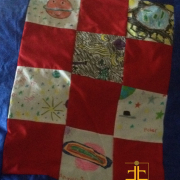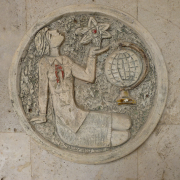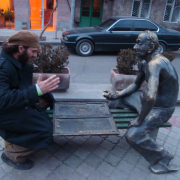Mystery Too Deep – Apb. Tiran, more
Armodoxy for Today: Mystery too Deep
The first hymn which is sung at the Divine Liturgy of the Armenian Church is Khorhourt khorin. It sets the tone of entire Liturgy. I remember the first time I read the translation of those words, “Mystery, deep, inscrutable, without beginning…”
The words to the hymn as well as the entire Divine Liturgy were translated by Archbishop Tiran Nersoyan, of blessed memory. He was one of the brilliant minds of the Armenian Church in the 20th century. His accolades are many, but among the top was his vision for having an Armenian seminary in the United States. He founded the St. Nersess Armenian Seminary. He was elected Patriarch of the Armenian Patriarchate of Jerusalem, and served as Primate of the Eastern Diocese.
1978 was a special time in my life. I had just returned from the Seminary of Holy Etchmiadzin and entered the Seminary at Claremont. As an Armenian student in this Methodist Seminary, I relied heavily on Archbishop’s Divine Liturgy translation for research comparisons and thesis development. 1978 also happened to be the centennial celebration of Albert Einstein’s birth. Not far from Claremont was Cal Poly Pomona, and I was able to enroll in a class simultaneously about Einstein, tailored for the non-scientist. It was there that I found this most meaningful quote by Einstein. “The most beautiful thing that we can experience is the mysterious. It is the source of all true art and all science. He to whom this emotion is a stranger, who can no longer pause to wonder and stand rapt in awe, is as good as dead; his eyes are closed.” He pointed to mystery and the awe awakened by that mystery. In essence, Einstein was uncovering a truth expressed by the Armenian Church for centuries.
In 1989 I received a letter from Archbishop Tiran, while I was pastoring at the St. Andrew Armenian Church in Cupertino, California. We had met only casually, but to receive a letter by the revered archbishop, the “Encyclopedia of the Armenian Church,” for me, was like being called out at a concert by the superstar on the stage because he recognized me! Me? Yes, you!
Yesterday I gave you the background of that letter. Today, as promised, I continue the story of our exchange. The letter was an invitation to edit a theological journal for the St. Nersess Seminary. His generous letter was flattering, and his offer to edit the journal was more than I could have imagined at that point in my ministry. He invited me to come to New York to meet with him to discuss the detail. I went there and spent three of the most memorable days in my life, just being around and living around this giant of the Armenian Church.
I visited the archbishop in his New York City apartment, in the Washington Heights area. It was next to the Holy Cross Armenian Church on 187th Street, a church which was infamously the site of the 1933 Assassination of the Archbishop Levon Tourian.
During my stay with the Archbishop Tiran, I want to say we discussed many topics, but it was more like he talked, and I listened. I was in awe of his intellect, and how he organized his thoughts. Indeed, what we knew from a distance, was even more pronounced in person, he was the Enclopedia of Christianity and a specialized volume of that encyclopedia focused on the Armenian Church.
On the second day of my visit Archbishop Tiran took me into the Holy Cross Armenian Church. It was the Lenten season and the curtain was closed. We came up the center isle and he pointed to the spot where Archbishop Ghevont was assassinated on Christmas day 1933. With his killings began the ugly divisions among the Armenian people and the Armenian Church in America. (Journalist Terry Phillips writes about the assassination in his book, Murder at the Altar.) He had the vestments of the murdered archbishop, with blood stains still uncleaned, pointing to where he was brutally stabbed during the service that day. Against this reality, the esoteric and spiritual discussion of mystery was going to be hard-find.
Archbishop Tiran took me up to the altar. With the curtain closed behind us, we stood in this narrow space in front of the main altar of Holy Cross. I began the conversation, citing the beautiful words with which he translated, Khorhourt Khorin…. Each of his words were selected perfectly for his translations. The word, “inscrutable” intrigued me. So with that admission, we began a conversation on mystery.
In Armenian Orthodoxy, you understand that God is beyond explanation. If you can describe God, then He isn’t God. Mystery – khorhourt – is the catch-all term for the Divine realm. With the groundwork laid, Archbishop Tiran asked me if I knew why there were 12 candles on the altar? “The 12 disciples,” I answered, “the twelve points of light.” He laughed. He had a very kind laugh that let you know he was amused. “No, the candles are in reference to the twelve signs of the zodiac.” I thought he was putting me on. The Zodiac? Isn’t that what Nancy Regan was being ridiculed for? Then, I looked in the Armenian Church calendar (Oratzuyts) published annually in Holy Etchmiadzin and there they were – the twelve signs, printed on the pages of the calendar. Mystery was fairly deep, in fact maybe too deep, until he asked me one more question, one which sent me over the top in its simplicity and explained Mystery in what we now refer to as in Armodox manner.
Until then, the prayer, Khorhourt khorin as translated by Archbishop Tiran Nersoyan, O mystery deep, inscrutable, without beginning. Thou that hast decked thy supernal realm as a chamber unto the light unapproachable and hast adorned with splendid glory the ranks of the fiery spirits…

 2014 Greg Beylerian
2014 Greg Beylerian

 2009 Fr. Vazken Movsesian
2009 Fr. Vazken Movsesian 2014 Gregory Beylerian
2014 Gregory Beylerian 2023 Fr. Vazken
2023 Fr. Vazken



 2014 Gregory Beylerian
2014 Gregory Beylerian
Leave a Reply
Want to join the discussion?Feel free to contribute!